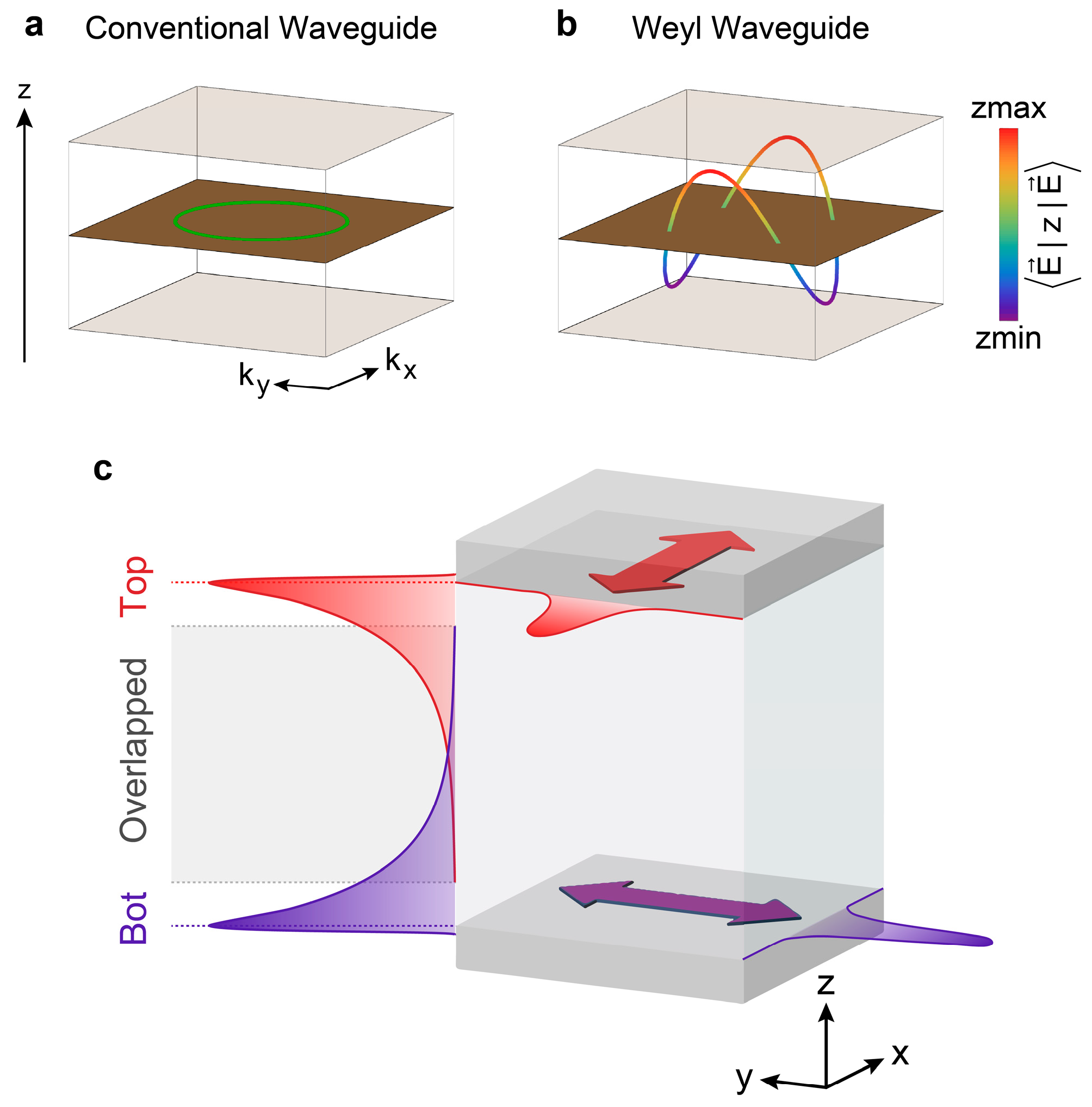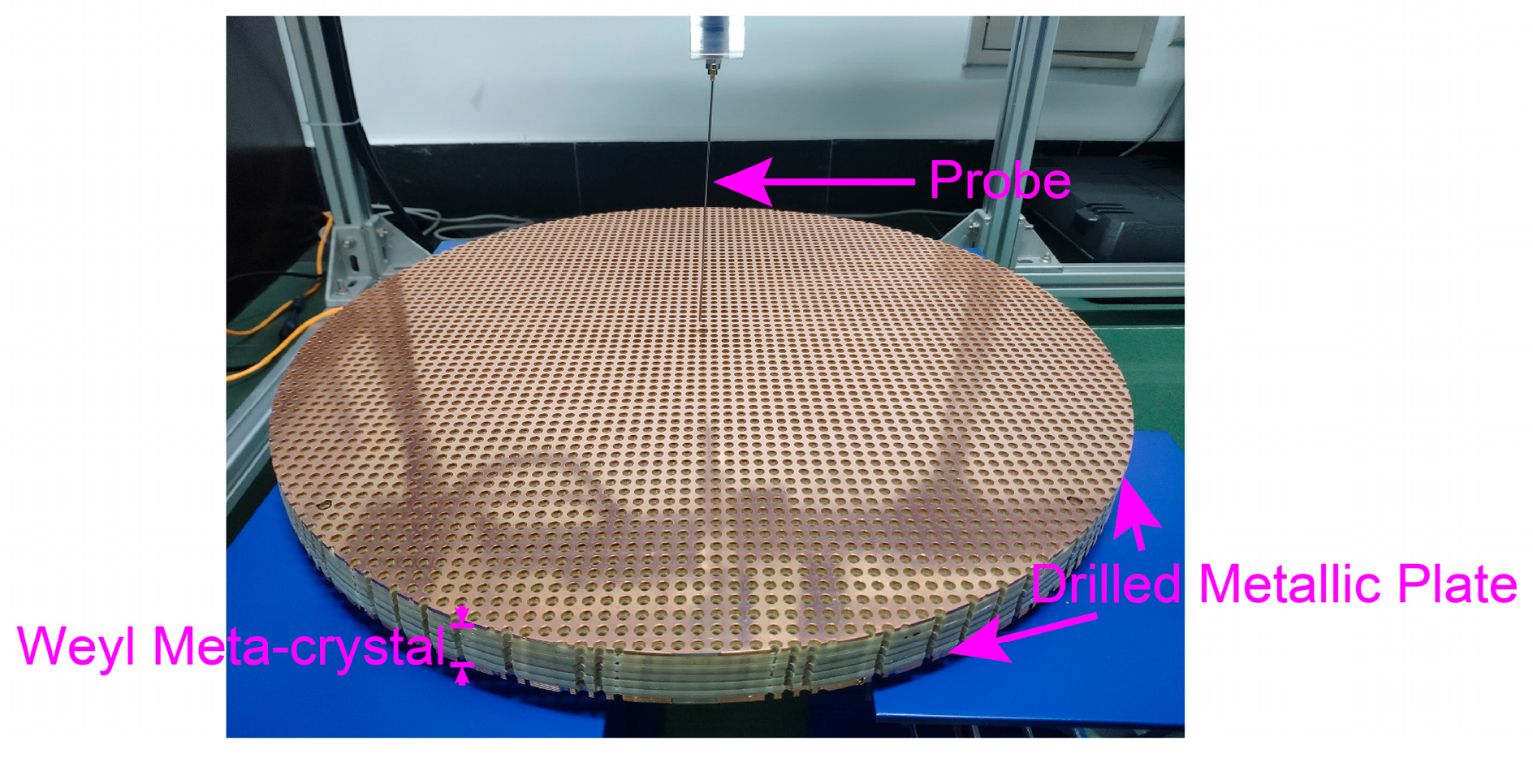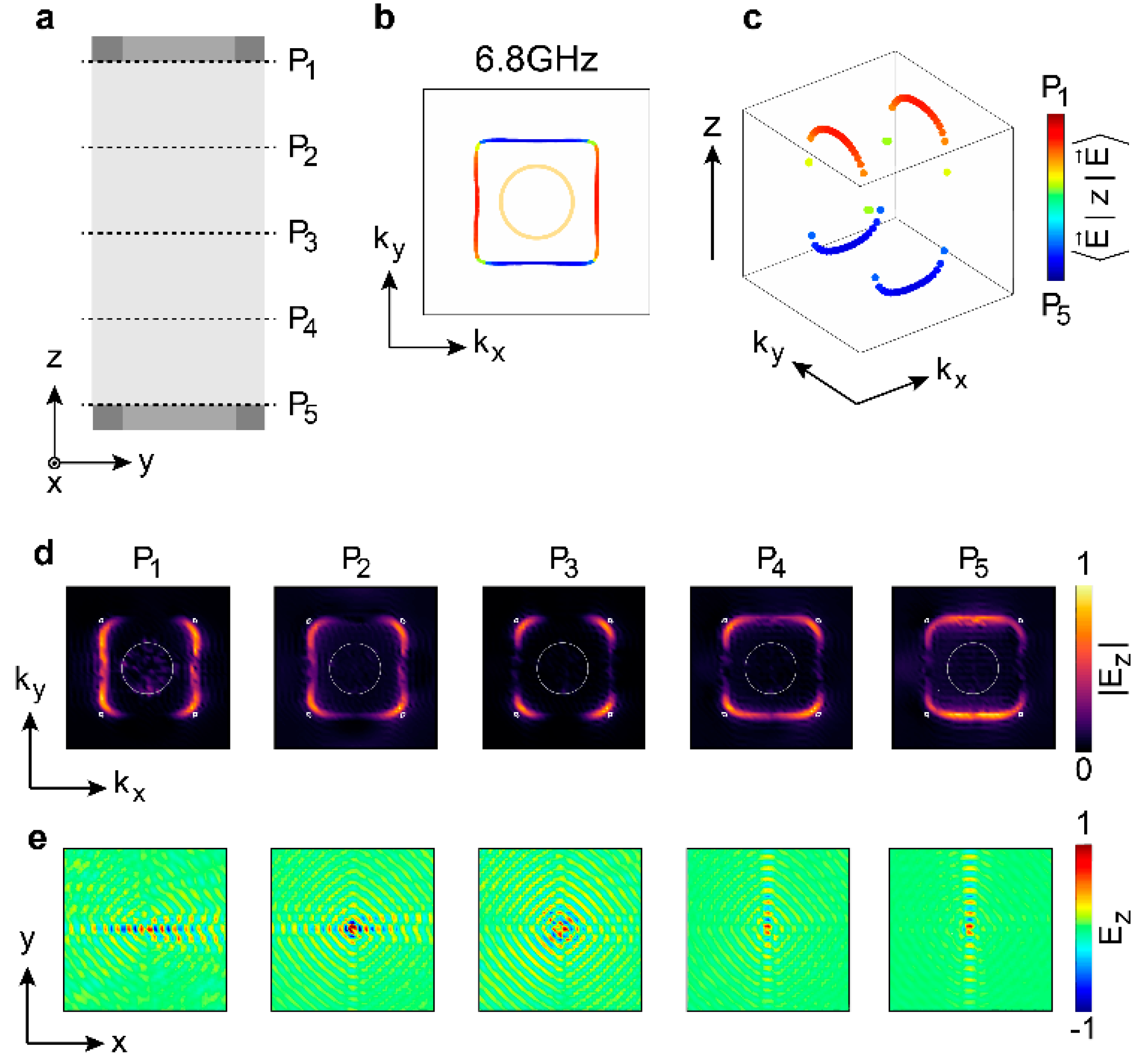Photonic Weyl Waveguide and Saddle-Chips-like Modes
Abstract
:1. Introduction
2. Materials and Methods
2.1. Numerical Simulation
2.2. Fabrication of the Experimental Sample
2.3. Source and Probe
3. Results
3.1. Topological Waveguide Modes
3.2. Observation of Saddle-Chips-like Mode
4. Discussion
5. Conclusions
Author Contributions
Funding
Data Availability Statement
Conflicts of Interest
References
- Zhang, K.; Li, D. Metallic Waveguides and Resonant Cavities. In Electromagnetic Theory for Microwaves and Optoelectronics; Zhang, K., Li, D., Eds.; Springer: Berlin/Heidelberg, Germany, 1998; pp. 213–288. [Google Scholar]
- Collin, R.E.; Chang, H. Field Theory of Guided Waves; IEEE Press: Piscataway, NJ, USA, 1990. [Google Scholar]
- Armitage, N.P.; Mele, E.J.; Vishwanath, A. Weyl and Dirac semimetals in three-dimensional solids. Rev. Mod. Phys. 2018, 90, 015001. [Google Scholar] [CrossRef]
- Ozawa, T.; Price, H.M.; Amo, A.; Goldman, N.; Hafezi, M.; Lu, L.; Rechtsman, M.C.; Schuster, D.; Simon, J.; Zilberberg, O.; et al. Topological photonics. Rev. Mod. Phys. 2019, 91, 015006. [Google Scholar] [CrossRef]
- Bansil, A.; Lin, H.; Das, T. Colloquium: Topological band theory. Rev. Mod. Phys. 2016, 88, 021004. [Google Scholar] [CrossRef]
- Yan, B.; Felser, C. Topological Materials: Weyl Semimetals. Annu. Rev. Condens. Matter Phys. 2017, 8, 337–354. [Google Scholar] [CrossRef]
- Fang, C.; Lu, L.; Liu, J.; Fu, L. Topological semimetals with helicoid surface states. Nat. Phys. 2016, 12, 936–941. [Google Scholar] [CrossRef]
- Wang, H.-X.; Lin, Z.-K.; Jiang, B.; Guo, G.-Y.; Jiang, J.-H. Higher-Order Weyl Semimetals. Phys. Rev. Lett. 2020, 125, 146401. [Google Scholar] [CrossRef] [PubMed]
- Vaidya, S.; Noh, J.; Cerjan, A.; Jörg, C.; von Freymann, G.; Rechtsman, M.C. Observation of a Charge-2 Photonic Weyl Point in the Infrared. Phys. Rev. Lett. 2020, 125, 253902. [Google Scholar] [CrossRef] [PubMed]
- Yang, Y.; Bi, Y.; Peng, L.; Yang, B.; Ma, S.; Chan, H.-C.; Xiang, Y.; Zhang, S. Veselago lensing with Weyl metamaterials. Optica 2021, 8, 249–254. [Google Scholar] [CrossRef]
- Xie, B.; Liu, H.; Wang, H.; Cheng, H.; Tian, J.; Chen, S. A Review of Topological Semimetal Phases in Photonic Artificial Microstructures. Front. Phys. 2021, 9, 771481. [Google Scholar] [CrossRef]
- Li, R.; Lv, B.; Tao, H.; Shi, J.; Chong, Y.; Zhang, B.; Chen, H. Ideal type-II Weyl points in topological circuits. Natl. Sci. Rev. 2021, 8, nwaa192. [Google Scholar] [CrossRef]
- Lan, Z.; Chen, M.L.N.; Gao, F.; Zhang, S.; Sha, W.E.I. A brief review of topological photonics in one, two, and three dimensions. Rev. Phys. 2022, 9, 100076. [Google Scholar] [CrossRef]
- Cheng, H.; Gao, W.; Bi, Y.; Liu, W.; Li, Z.; Guo, Q.; Yang, Y.; You, O.; Feng, J.; Sun, H.; et al. Vortical Reflection and Spiraling Fermi Arcs with Weyl Metamaterials. Phys. Rev. Lett. 2020, 125, 093904. [Google Scholar] [CrossRef] [PubMed]
- Biao, Y.; Qinghua, G.; Tremain, B.; Rongjuan, L.; Barr, L.E.; Qinghui, Y.; Wenlong, G.; Hongchao, L.; Yuanjiang, X.; Jing, C.; et al. Ideal Weyl points and helicoid surface states in artificial photonic crystal structures. Science 2018, 359, 1013–1016. [Google Scholar]
- Breitkreiz, M.; Brouwer, P.W. Fermi-Arc Metals. Phys. Rev. Lett. 2023, 130, 196602. [Google Scholar] [CrossRef] [PubMed]
- Yang, B.; Guo, Q.; Tremain, B.; Barr, L.E.; Gao, W.; Liu, H.; Béri, B.; Xiang, Y.; Fan, D.; Hibbins, A.P.; et al. Direct observation of topological surface-state arcs in photonic metamaterials. Nat. Commun. 2017, 8, 97. [Google Scholar] [CrossRef] [PubMed]
- Jia, S.; Xu, S.-Y.; Hasan, M.Z. Weyl semimetals, Fermi arcs and chiral anomalies. Nat. Mater. 2016, 15, 1140–1144. [Google Scholar] [CrossRef] [PubMed]
- Ilan, R.; Grushin, A.G.; Pikulin, D.I. Pseudo-electromagnetic fields in 3D topological semimetals. Nat. Rev. Phys. 2020, 2, 29–41. [Google Scholar] [CrossRef]
- Gao, W.; Yang, B.; Lawrence, M.; Fang, F.; Béri, B.; Zhang, S. Photonic Weyl degeneracies in magnetized plasma. Nat. Commun. 2016, 7, 12435. [Google Scholar] [CrossRef] [PubMed]
- Lv, B.Q.; Qian, T.; Ding, H. Experimental perspective on three-dimensional topological semimetals. Rev. Mod. Phys. 2021, 93, 025002. [Google Scholar] [CrossRef]
- Giwa, R.; Hosur, P. Fermi Arc Criterion for Surface Majorana Modes in Superconducting Time-Reversal Symmetric Weyl Semimetals. Phys. Rev. Lett. 2021, 127, 187002. [Google Scholar] [CrossRef] [PubMed]
- Nguyen, D.H.M.; Devescovi, C.; Nguyen, D.X.; Nguyen, H.S.; Bercioux, D. Fermi Arc Reconstruction in Synthetic Photonic Lattice. Phys. Rev. Lett. 2023, 131, 053602. [Google Scholar] [CrossRef] [PubMed]
- Lau, A.; Koepernik, K.; van den Brink, J.; Ortix, C. Generic Coexistence of Fermi Arcs and Dirac Cones on the Surface of Time-Reversal Invariant Weyl Semimetals. Phys. Rev. Lett. 2017, 119, 076801. [Google Scholar] [CrossRef] [PubMed]
- Murthy, G.; Fertig, H.A.; Shimshoni, E. Surface states and arcless angles in twisted Weyl semimetals. Phys. Rev. Res. 2020, 2, 013367. [Google Scholar] [CrossRef]
- Zheng, Y.; Chen, W.; Xing, D.Y. Andreev reflection in Fermi-arc surface states of Weyl semimetals. Phys. Rev. B 2021, 104, 075420. [Google Scholar] [CrossRef]
- Zhang, C.; Zhang, Y.; Lu, H.-Z.; Xie, X.C.; Xiu, F. Cycling Fermi arc electrons with Weyl orbits. Nat. Rev. Phys. 2021, 3, 660–670. [Google Scholar] [CrossRef]
- Yang, H.F.; Yang, L.X.; Liu, Z.K.; Sun, Y.; Chen, C.; Peng, H.; Schmidt, M.; Prabhakaran, D.; Bernevig, B.A.; Felser, C.; et al. Topological Lifshitz transitions and Fermi arc manipulation in Weyl semimetal NbAs. Nat. Commun. 2019, 10, 3478. [Google Scholar] [CrossRef] [PubMed]
- Ekahana, S.A.; Li, Y.W.; Sun, Y.; Namiki, H.; Yang, H.F.; Jiang, J.; Yang, L.X.; Shi, W.J.; Zhang, C.F.; Pei, D.; et al. Topological Lifshitz transition of the intersurface Fermi-arc loop in NbIrTe4. Phys. Rev. B 2020, 102, 085126. [Google Scholar] [CrossRef]
- Xia, L.; Gao, W.; Yang, B.; Guo, Q.; Liu, H.; Han, J.; Zhang, W.; Zhang, S. Stretchable Photonic ‘Fermi Arcs’ in Twisted Magnetized Plasma. Laser Photonics Rev. 2017, 12, 1700226. [Google Scholar] [CrossRef]
- Abdulla, F.; Rao, S.; Murthy, G. Fermi arc reconstruction at the interface of twisted Weyl semimetals. Phys. Rev. B 2021, 103, 235308. [Google Scholar] [CrossRef]
- Buccheri, F.; Egger, R.; De Martino, A. Transport, refraction, and interface arcs in junctions of Weyl semimetals. Phys. Rev. B 2022, 106, 045413. [Google Scholar] [CrossRef]
- Goutte, L.; Pereg-Barnea, T. Coupling between a Weyl semimetal and a nontopological metal. Phys. Rev. B 2023, 108, 035118. [Google Scholar] [CrossRef]
- Dwivedi, V. Fermi arc reconstruction at junctions between Weyl semimetals. Phys. Rev. B 2018, 97, 064201. [Google Scholar] [CrossRef]
- Slager, R.-J.; Juričić, V.; Roy, B. Dissolution of topological Fermi arcs in a dirty Weyl semimetal. Phys. Rev. B 2017, 96, 201401. [Google Scholar] [CrossRef]
- Jia, H.; Zhang, R.; Gao, W.; Guo, Q.; Yang, B.; Hu, J.; Bi, Y.; Xiang, Y.; Liu, C.; Zhang, S. Observation of chiral zero mode in inhomogeneous three-dimensional Weyl metamaterials. Science 2019, 363, 148–151. [Google Scholar] [CrossRef] [PubMed]
- Han, N.; Chen, F.; Li, M.; Zhao, R.; Li, W.; Chen, Q.; Zhang, L.; Pan, Y.; Ma, J.; Yu, Z.-M.; et al. Boundary-induced topological chiral extended states in Weyl metamaterial waveguides. arXiv 2024, arXiv:2401.11780. [Google Scholar]





Disclaimer/Publisher’s Note: The statements, opinions and data contained in all publications are solely those of the individual author(s) and contributor(s) and not of MDPI and/or the editor(s). MDPI and/or the editor(s) disclaim responsibility for any injury to people or property resulting from any ideas, methods, instructions or products referred to in the content. |
© 2024 by the authors. Licensee MDPI, Basel, Switzerland. This article is an open access article distributed under the terms and conditions of the Creative Commons Attribution (CC BY) license (https://creativecommons.org/licenses/by/4.0/).
Share and Cite
Wang, H.; Xu, W.; Zhu, Z.; Yang, B. Photonic Weyl Waveguide and Saddle-Chips-like Modes. Nanomaterials 2024, 14, 620. https://doi.org/10.3390/nano14070620
Wang H, Xu W, Zhu Z, Yang B. Photonic Weyl Waveguide and Saddle-Chips-like Modes. Nanomaterials. 2024; 14(7):620. https://doi.org/10.3390/nano14070620
Chicago/Turabian StyleWang, Hanyu, Wei Xu, Zhihong Zhu, and Biao Yang. 2024. "Photonic Weyl Waveguide and Saddle-Chips-like Modes" Nanomaterials 14, no. 7: 620. https://doi.org/10.3390/nano14070620




